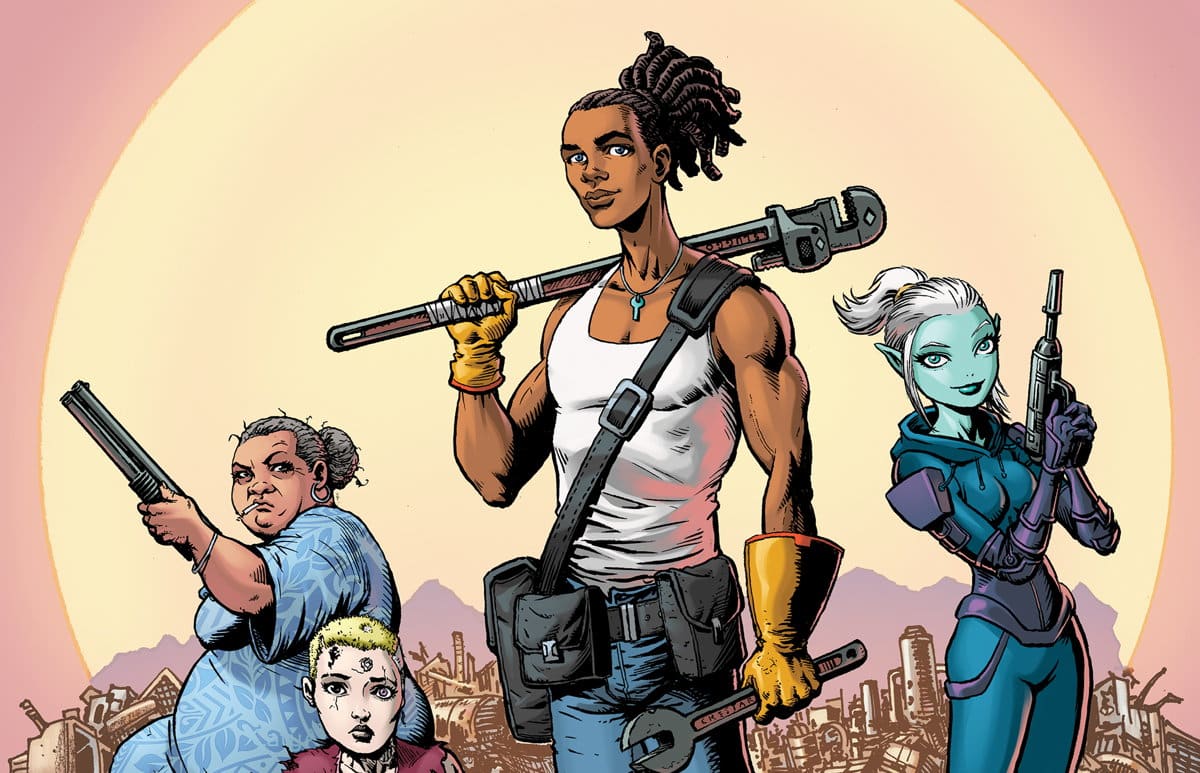By Matt O’Keefe
In the world wide web there’s a lot that goes unnoticed, even in more niche industries like comics. For the last few years artist Gannon Beck, along with various writers, has been telling tales of the Spaces Corps, a guild reminiscent of the Green Lantern Corps at DC or the Nova Corps at Marvel. What separates it from those is its authenticity in depicting actual military life, thanks in large part to Beck’s time in the Marines. The zero issue is currently funding its print run on Kickstarter while the third issue is going strong as a webcomic. I talked with Gannon Beck about the evolution Space Corps from how it started to what’s coming next.
What was your background in comics before Space Corps?
In high school I did comics with a friend. We did them for fun, but looking back, I have to say that those comics projects were instrumental in developing my illustration ability. We also did a few gag strips—one strip about aliens that crash landed on earth that we tried unsuccessfully to get syndicated, and another strip called The Big Gap that was about a retired Marine living with his grandson. We did The Big Gap as a webcomic for a few years. It eventually petered out, but it was fun and helped hone our writing and drawing skills. It’s actually really hard to write captivating strips in four panels. I like the long form format of comic books much better; however, because of how we set up the grid for Space Corps, which is 4 x 4 panels, I can smuggle a daily strip style of writing into the pages.
You explain well how Space Corps got started on the Kickstarter page, but how did you connect with your other collaborators on the project?
Joey Groah was the instigator. Joey heard about an art class that I taught every week at the local comic book shop and stopped by to introduce himself. He was already a member of Comics Experience and introduced me to a bunch of people on the workshop. He also introduced me to his childhood friend and writer, Bryan Richmond. Especially at the beginning of my time at Comics Experience, I did a bunch of short stories with various writers. The collaboration with Bryan led to Space Corps and stories just kept erupting from it. Rather than fight it, we just went with it.
You’re a very capable writer, so why did you collaborate with other writers for Space Corps #0 and beyond?
There is no question that Space Corps wouldn’t be the same, and wouldn’t be as good, had I tried to do it on my own. In a creative collaboration like ours, the ideas spark off of each other to form new ideas and concepts.
Take issue 3, for instance. In coming up with the characters in that issue, it was Bryan and I throwing ideas back and forth that made them what they are. Once those characters inserted themselves into the story structure, it took on a life of its own. Once you place a character like Sheg into a boot camp environment, there is a logic as to what that story alchemy is going to be. It was important to me to do an issue on boot camp because it’s one of those touchstone military experiences that all military people share. The idea of Sheg as a character, however, started with Bryan. Even though we’re only half way through the issue, try to imagine the story without Sheg. For that matter, try to imagine the story without Cazarez, who also started with Bryan. I can’t do it. It just wouldn’t be the same story.
I love the story we’re telling, and I love the characters. I also love the process of working these things out with Bryan. We’re having a good time doing this, and I think that shows up in the work as well.
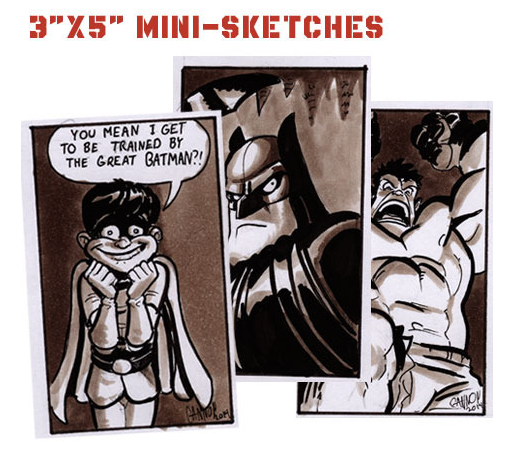
How have you been promoting Space Corps the webcomic and, more recently, Space Corps the Kickstarter?
For the most part, it has been social media and conventions. It’s a looong road, though. It can take a long time to build an audience.
Recently we’ve been experimenting with breaking up the pages into dailies. The 16 panel grid lends itself to that really well. We post the dailies on Facebook and Twitter, and that has increased engagement a lot. In the documentary, Stripped, Bill Watterson talked about how when daily newspapers were thriving, comic strips became a part of people’s daily routine—a part of their ritual. Breaking the pages into dailies is our attempt to get back to that.
All of this is ironic. The first comic books were just repackaged daily strips from newspapers. Eventually, publishers started commissioning new material, and the form evolved. Now, with the internet and people’s limited attention spans, we’re reverse engineering the comics page to get back to where it all started—the daily strip.
The point is to make it easy to keep up with—give people bite-sized chunks. Even though we read strips like Calvin and Hobbes in collected volumes, the way people initially fell in love with it was in tiny bits at a time. So that’s why we want you to be able to read Space Corps from the comfort of your own feed.
Is that a smart marketing move? We’ll see, but that’s the thinking behind it.
The military community is known for being an especially supportive one. Has your background played a role in the success of the campaign so far?
It has helped, for sure. People who have been around the military really have supported the comic. Not only veterans like it but their families as well. It feels really good when I put a thought in Deven’s head and a whole bunch of veterans say they’ve had the same thoughts. The first page of issue #3 when Deven is thinking about how to get through the day, for instance, particularly seemed to hit home.
The cultural authenticity in Space Corps is very important to both Bryan and me. When we get it right, people in the military will see a little of themselves and those they serve with in the story. In turn, they’ve been among our biggest supporters.
Aside from the military audience, there are comic book people who really like it as well. That’s been such a boost to us to get all the encouragement we have from people we meet at cons and on the Comics Experience. It gives us the confidence to think maybe we’re not entirely crazy for thinking this is good. Because we’re producing pages without pay, the encouragement we get from both the military and the creative community really helps. We don’t take it for granted at all and are so appreciative for those who have taken a chance on it and liked it.
Kickstarters for single issues are difficult because with shipping you have to charge a high price for one comic. You’re offering the print copy of Space Corps #0 for $8, which is cheaper than some I’ve seen. Still, are you getting any blowback on the cost?
It doesn’t seem to be the case. Sure, we would probably get more if we had a 120 page volume we were offering, but it would also be more expensive to print, so we would need more money. With crowdfunding, it has as much or more to do with helping the endeavor than it does getting the cool thing. At least that’s how I feel about it when I’m supporting someone’s campaign. Don’t get me wrong, I want the thing, but it’s more than that; I want the thing to exist, and I’m willing to pay a little more to help it exist.
When people give us $8 to cover the shipping, I think it’s because of a “help-get-it-off-the-ground” kind of thinking. They know they are helping us bring this into the world. They become a part of the art creation, not just the consumption.
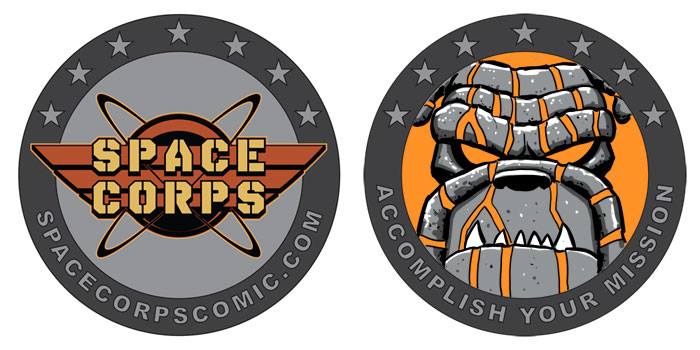
Do you have stretch marks in mind if you exceed your goal?
We do. The first stretch goal will be a challenge coin. Military units routinely get challenge coins with their unit logo on them. We think it would be cool to do one for Capt Brockett’s unit, the one Deven will end up attached to. If we reach that, we’ll see if we can come up with something else. We really can’t dangle things like, “If you give us more money, we’ll give you more Space Corps,” because more Space Corps is coming no matter what. Bryan and I are committed to telling these stories.
What do you want out of this Kickstarter, other than funding?
Other than funding, the marketing Kickstarter provides is helpful. We want to keep growing our audience. We’re proud of the work, and we think a lot more people, military and civilians alike, would like it if they just read it. If more people have read Space Corps because of the Kickstarter, then that’s a success in addition to the funding.
It doesn’t look like we’ll go ridiculously over our Kickstarter goal, so none of this money is going to go to Bryan, Joey and me. If we go over the amount we’re asking for, it’s going to go into printing more books. The more books we can get into circulation, the more people have a chance to fall in love with the characters. At this stage of the project, that’s our focus.
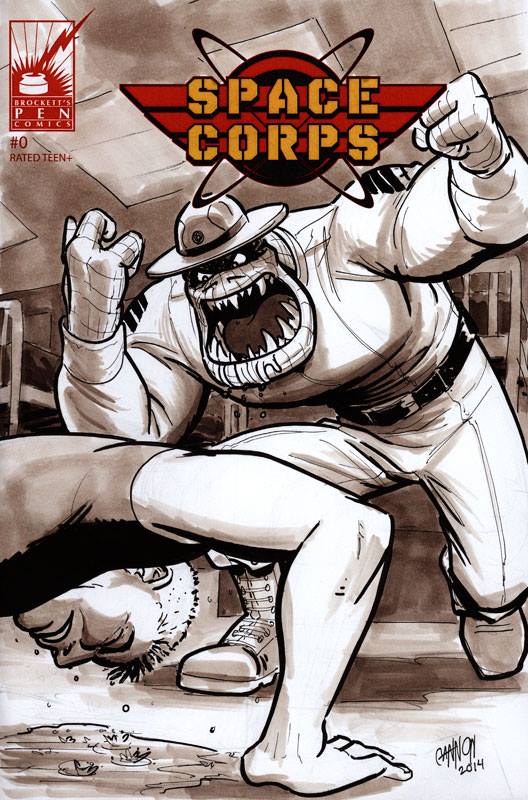
The subsequent issues of Space Corps are gray wash, not color. Is that how you’ll print them?
We treat the short stories differently than the ongoing series. After issue #0 we really want to break the series off into two different series. One series will just contain 8 page short stories like we saw in issue #0. I’m not even sure that we know what we want to call the short story series. With the short stories, though, we can be expansive– go forwards or backwards in time to tell a story. I can get experimental with the art and work with other creators. A lot of writers have expressed interest in writing Space Corps short stories, and I think it’s a great idea. Most of those, if not all, will be in color.
The main story, which is more linear than the short stories, is a part of a grand structure. The gray tones are important because, even though it’s science fiction, we intentionally want to invoke a connection with WW2 and WW1. Most photos and film we see of those periods are in black and white, so by using gray tones, we can tap into those motifs thematically and emotionally. I experimented with different styles, even water color in the way Matt Kindt works on MIND MGMT, but thematically gray tones made more sense.
I also want the main series to look hand drawn. I love looking at combat art, and most work done by combat artists tends to be gestural. I want the readers to be aware they are looking at something that is drawn by hand.
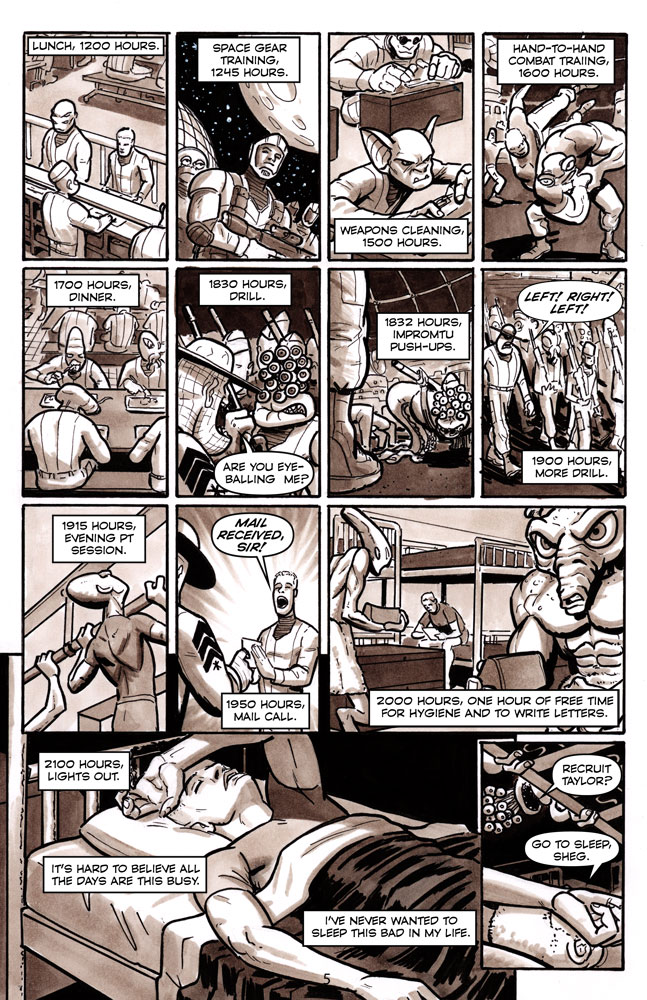
I’m really excited to see future issues hit publication, because you really open up your work. I’m astounded with how effortless you make a 16-panel page look. I can’t imagine asking for that panel count from an artist, but you co-write this so you must enjoy them.
Thanks. It’s a function of knowing how to use the grid. Because we want to make each issue about something, even if it’s a part of a larger arc, we sometimes need to have high panel counts. Sometimes we’ll fit 2 to 3 pages of story onto a single page. A strict grid used with strict rules helps organize the information in a way that make it work. I can easily use repetition and contrast in the layout in a way that makes the reader pause or shift gears on a page when I want them to.
You’re in the midst of Issue 3 of Space Corps as a webcomic. When does the first arc end?
The first arc ends in issue 6. In the first three issues, we wanted you to get a feel for who Deven is before he joins the Space Corps. The internment camp, leaving home, and boot camp are all important stories. They give context to Deven’s evolution as a person as he deals with becoming a cog in the machinery of war. In issues 4, 5, and 6 the situation is going to get exponentially more harrowing for Deven. If you’ve been loving it so far, you are in for a ride.
After that, what’s next for Space Corps?
After the first arc, we need to figure out what the second arc will be. We’ve got plenty of ideas, and it’s just a matter of narrowing it down and picking the next story we want to tell. Ultimately we’ll pick the strongest and most logical story to tell after issue #6.
It’s possible we may find a publisher for the first arc, but if not, we’ll Kickstart the trade.
Beyond even the first and second arcs, we know where the story is headed, and we’ve got tent poles of the story figured out along the way—at least in broad terms. Whether it takes 20 issues to get to the end or 70 issues, we don’t know. It’s way more than six, though.
What have you been working on recently other than Space Corps?
As far as comics, I’m doing the layouts for Past the Last Mountain with Paul Allor and Louie Joyce. It’s been a ton of fun.
I also do some parody comics for kicks. I’ve done a Batman parody with my friend, Troy McDevitt, where Batman is interviewing a new Robin because he goes through so many. Troy and I also did a Star Wars parody about how the Death Star was so poorly designed they only included one bathroom. The whole story is about Emperor Palpatine hogging the bathroom. Troy and I have known each other since we were teenagers and these stories come about from us cracking each other up making jokes. I do the parody comics very loose, just to get the jokes out of my system. I don’t spend a ton of time on them but they’re fun.
What are your short term goals as a comic book creator?
Just to keep getting better at the craft and figuring out ways to increase production on the cheap. There is nothing really sexy about it. I read everything I can. I see what’s working for other creators, and when I see a process or tool that’s interesting, I try it out to see if it works for me.
How about long term? Where do you want to be in [x] years?
Space Corps is it for the foreseeable future. It’s going to take years to get this story out. I’m not opposed to work-for-hire on small projects, but I’ve never viewed Space Corps as a stepping-stone to work-for-hire. Space Corps is what I want to do.
For me, Space Corps more than just a cool science fiction story. It’s a vehicle to help process a lifetime spent around the military. Military service has been a family affair. The heaviest fighting seen in my family, and possibly in all of history, was on Tarawa and Iwo Jima, where my grandfather served as a Sea Bee. It’s why Cpl Hive is full of bees. He is an homage to my grandfather. In a larger sense, though, the world has grown up in the wake of WW2. I’ve grown especially aware of how we’re still affected by the ripples of the war. I’ve lived in Japan both as child and an adult as a part of the treaty signed at the end of the war. I lived in Berlin at the end of high school, surrounded by a wall erected in the aftermath of how Germany was divided when the Third Reich fell. That gave me a front row seat to the end of the cold war when the wall fell. I stood on the wall, shoulder to shoulder with East and West Germans, the night freedom took hold of all of Germany.
WW2 isn’t the only historical inspiration for Space Corps. That said, even Vietnam, Korea, and the wars in the Gulf have to be looked at a little through the lens of WW2. WW2 brought on the nuclear age. Also during WW2, America reflexively emerged as a world military power that has remained unrivaled until this day. The military we have today is a result of the military that was built during the 40s. We had a strong military in place for the conflicts in Korea and later, Vietnam. Caught in the current of history, my dad fought and was wounded in Vietnam. Two of my uncles fought in Vietnam as well, one who was killed in combat, leaving behind his pregnant wife.
My older brother was the first to join out of my family in my generation. He joined the Marine infantry and was in one of the first units into Kuwait during the first Gulf War.
My own military experience, while unremarkable, helps give me insights I wouldn’t otherwise have. While my brother was liberating Kuwait, I was in boot camp. The cease fire was called days before I graduated from Parris Island, and I enjoyed a hero’s welcome on boot leave for doing nothing. The nation reflexively and consciously made sure it treated veterans better than it had after Vietnam. As a result, I received the free sodas and thanks my brother earned. In March of 1991, while I got to soak it up, he was still living in a shallow hole in the desert. Whereas I got to witness the cold war break down in Berlin as a bystander, I helped monitor its end doing intelligence work in the Marines. In Korea I stood on the DMZ and listened to both countries blast propaganda on loudspeakers like quarrelling children. The contrast of standing on a demarcation of oppression as it dissolved, like it did in Berlin, and standing on one that was still festering, like in Korea, was stark to say the least.
When out of the Marines, as a volunteer, I helped high schoolers get in shape for boot camp. As a result, I’ve met the kids in my community as they signed up for service in the midst of two wars. I’ve seen the mix of pride and apprehension on their parents’ faces as they said their good-byes, knowing their children would likely end up in a warzone.
Then there is the logo work I do for the military, which has given me yet another perspective. Through the most recent wars I’ve talked almost daily with the men and women doing the fighting. For over a decade I’ve collaborated with Marines, soldiers, airmen and sailors about artwork that best captures how they view themselves. I’ve done over 2000 of these designs —each and every one of the logos a collaboration with the unit. The resulting art is a record of the mindset of warfighters as they prepare for and fight wars.
War is the most serious of human endeavors. The stakes couldn’t be higher for civilizations and the individuals who wage it. Space Corps is a way to get at themes and topics related to war that we don’t think about maybe as often as we should. Lurking in Space Corps are a lot of stories I need to explore. In comics, my long-term goal is to keep telling this story.







